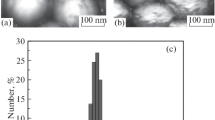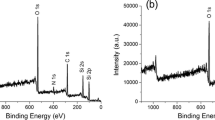Abstract
Silica composited flower-like microspheres were synthesized by a facile sol–gel synthesis method using trivalent europium tartrate (Eu3+-TTA) as the template. Fourier transform infrared spectra (FT-IR) X-ray photoelectron spectroscopy (XPS), X-ray diffraction analyses (XRD), Energy-dispersive X-ray (EDS) spectroscopy, scanning electron microscopy (SEM), thermogravimetry-differential thermal analysis (TG-DTA) were employed to characterize the composition, structure, and morphology of the products. The microspheres were composed of nanosheets as petals. Size of the spherical shape varied with the amount of tetraethoxysilane (TEOS) addition. As the addition of TEOS decreased the diameters of microspheres increased, and it was proven that Eu3+ ions existed in the form of Si–O–Eu covalent bond. Furthermore, a sol–gel templated mechanism is proposed to interpret the formation process of flower-like microspheres shape. The hollow-liked microspheres were obtained by a following calcination process. In addition, photoluminescent emission of the products was further discussed, which indicated that Eu3+ ions exhibit characteristic luminescent emissions and their luminescent intensity after calcination is higher than that of as-synthesized sample.
Graphical abstract
The silica composited microspheres with flower-like shape were prepared successfully by a facile sol–gel synthesis method using trivalent europium tartrate (Eu3+-TTA) as a template. A sol–gel templated mechanism was proposed to interpret the formation process of flower-like shape microspheres. During this process, Eu3+-tartrate was supposed to form supramolecular template by self-assembly and coordinate with silica oligomer by means of intermolecular interactions. Furthermore, it was indicated that Eu3+ exhibits strong characteristic luminescence in this system.









Similar content being viewed by others
References
Liu X, Lin C, Lin J (2007) White light emission from Eu3+ in CaIn2O4 host lattices. Appl Phys Lett 90:081904
Sohn K-S, Shin N (2002) Energy transfer between Tb3+ ions in Y4−xTbx Al2O9 phosphor. Electrochem Solid-State Lett 5:H21–H23
Song Y, Xu X, Zou H, Sheng Y, You H (2012) MSi2O2−δN2+ 2/3δ:Eu (M=Sr, Ba) phosphors for field emission displays. J Alloy Compd 513:86–90
Yue MB, Xue T, Jiao WQ, Wang YM, He M-Y (2011) CTAB-directed synthesis of mesoporous γ-alumina promoted by hydroxy carboxylate: the interplay of tartrate and CTAB. Solid State Sci 13:409–416
Miura K, Suzuki T, Hanaizumi O (2015) Photoluminescence properties of europium and cerium co-doped tantalum-oxide thin films prepared using co-sputtering method. J Mater Sci Chem Eng 03:30–34
Chen L, Lei X, Chen G, Zhong R, Lan S, Liang X, Lu J (2015) Synthesis, characterization and photophysical properties of phenanthroline derivatives and their europium complexes. J South-Cent Univ Natl 18:1315–1322
Varma C, Yafet Y (1976) Magnetic susceptibility of mixed-valence rare-earth compounds. Phys Rev B 13:2950
Luneau D, Rey P (2005) Magnetism of metal-nitroxide compounds involving bis-chelating imidazole and benzimidazole substituted nitronyl nitroxide free radicals. Coord Chem Rev 249:2591–2611
Gao Z, Shi Y (2010) Suppressed formation of CO2 and H2O in the oxidative coupling of methane over La2O3/MgO catalyst by surface modification. J Nat Gas Chem 19:173–178
Willbold M (2016) Europium. Living Reference Work Entry, Encyclopedia of Geochemistry, Part of the series Encyclopedia of Earth Sciences Series, pp 1–3
Si L, Yue L, Jin D (2011) Solvothermal synthesis of flower‐like lanthanum tartrate and lanthanum oxide microspheres in ethanol–water mixed system. Cryst Res Technol 46:1149–1154
Wang Y, Liu G-X, Chen Y-C, Wang K-B, Meng S-G (2010) Two novel lanthanum–tartrate complexes with distinctive new topologies: hydrothermal synthesis and crystal structures. Inorg Chim Acta 363:2668–2672
And ELL, Wachs IE (2015) In situ spectroscopic investigation of the molecular and electronic structures of SiO2 supported surface metal oxides. J Phys Chem C 111:14410–14425
Soga K (2015) Highly isospecific, immobilized zirconocene catalysts supported on chemically modified SiO2. Macromol Symp 89:249–258
Tang F, Li L, Chen D (2012) Mesoporous silica nanoparticles: synthesis, biocompatibility and drug delivery. Adv Mater 24:1504–1534
Li L-L, Fang C-J, Sun H, Yan C-H (2008) Hierarchical self-assembly of pH-responsive nanocomposites with molecular-scale and mesoscale periodicities. Chem Mater 20:5977–5986
Buso D, Nairn KM, Gimona M, Hill AJ, Falcaro P (2016) Fast synthesis of MOF-5 microcrystals using Sol−Gel SiO2 nanoparticles. Chem Mater 23:929–934
Deng X, Qin P, Luo M, Shao E, Zhao H, Yang X, Wang Y, Shen H, Jiao Z, Wu M (2013) Mesoporous silica coating on carbon nanotubes: layer-by-layer method. Langmuir 29:6815–6822
Duan L, Chen M, Zhou S, Wu L (2009) Synthesis and characterization of poly (N-isopropylacrylamide)/silica composite microspheres via inverse Pickering suspension polymerization. Langmuir 25:3467–3472
Firdous A, Quasim I, Ahmad MM, Kotru PN (2009) Studies on gel-grown pure and strontium-modified lanthanum tartrate crystals. J Cryst Growth 311:3855–3862
Haranath D, Gandhi N, Sahai S, Husain M, Shanker V (2010) Highly emissive and low refractive index layers from doped silica nanospheres for solar cell applications. Chem Phys Lett 496:100–103
Hunag W-H, Shieh J-M, Lien Y-C, Jhou K-J, Tu C-H, Wang C, Shen C-H, Hsieh W-H, Kuo H-C, Pan F-M (2012). Novel solar down-conversion luminescent and switchable interface polarization material by europium doped Si–O polar structures, In Quantum Electronics and Laser Science Conference, Optical Society of America, p JTh4J. 5
Uwamino Y, Ishizuka T, Yamatera H (1984) X-ray photoelectron spectroscopy of rare-earth compounds. J Electron Spectrosc Relat Phenom 34:67–78
Her J-L, Lin C-W, Chang K-Y, Pan T-M (2012). Label-free detection of creatinine using a disposable poly-N-isopropylacrylamide as an encapsulating creatinine deiminase based Eu 2 Ti 2 O 7 electrolyte-insulator-semiconductors. Int J Electrochem Sci 7
Shui M, Song Y, Ren Y, Wang X (2010) Structural analysis of amorphous silica prepared by water glass-based precursors and its thermal, spectral characterization. Phys B: Condens Matter 405:1316–1320
Chen W, Sammynaiken R, Huang Y (2000) Photoluminescence and photostimulated luminescence of Tb 3+ and Eu 3+ in zeolite-Y. J Appl Phys 88:1424–1431
Wan N, Xu J, Lin T, Zhang X, Xu L (2008). Energy transfer and enhanced luminescence in metal oxide nanoparticle and rare earth codoped silica. Appl Phys Lett 92
Tagaya M, Ikoma T, Yoshioka T, Motozuka S, Xu Z, Minami F, Tanaka J (2011) Synthesis and luminescence properties of Eu (III)-doped nanoporous silica spheres. J Colloid Interface Sci 363:456–464
Nassar EJ, Ciuffi KJ, Ribeiro SJL, Messaddeq Y (2003) Europium incorporated in silica matrix obtained by sol-gel: luminescent materials. Mater Res 6:557–562
Berry A, King T (1989) Characterisation of doped sol–gel derived silica hosts for use in tunable glass lasers. J Phys D Appl Phys 22:1419
Acknowledgements
This present work was financially supported by the scientific research project of Inner Mongolia University for the Nationalities (NMDYB1765) and the Opening Research Funds Projects of Key Laboratory of Inner Mongolia Autonomous Region of Chemistry of Natural Product and Functional Molecular Synthesis, Inner Mongolia University for the Nationalities (MDK2016012).
Author information
Authors and Affiliations
Corresponding author
Ethics declarations
Conflict of interest
The authors declare that they have no competing interests.
Rights and permissions
About this article
Cite this article
Gao, F., Sheng, Y., Song, Y. et al. Sol–gel synthesis of silica composited flower-like microspheres using trivalent europium tartrate as a template. J Sol-Gel Sci Technol 85, 470–479 (2018). https://doi.org/10.1007/s10971-017-4551-4
Received:
Accepted:
Published:
Issue Date:
DOI: https://doi.org/10.1007/s10971-017-4551-4




